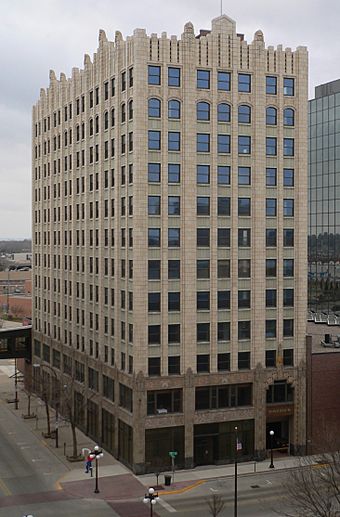Badgerow Building facts for kids
Quick facts for kids |
|
|
Badgerow Building
|
|

Badgerow Building, seen from the northeast.
|
|
| Location | 622 4th St. Sioux City, Iowa |
|---|---|
| Built | 1933 |
| Architect | K. E. Westerlind |
| Architectural style | Art Deco |
| NRHP reference No. | 82002646 |
| Added to NRHP | March 24, 1982 |
The Badgerow Building is a historic building in downtown Sioux City, Iowa, United States. It stands tall at twelve stories, reaching about 169 feet (51 meters) into the sky. For many years, it was the tallest building in Sioux City!
This important building was added to the National Register of Historic Places in 1982. It was also chosen as one of the 50 Most Significant Iowa Buildings of the 20th Century. This special honor came from the Iowa Chapter of the American Institute of Architects. The Badgerow Building was one of five buildings picked to represent the 1930s.
Building Style: Art Deco
The Badgerow Building was designed by a Sioux City architecture company called K. E. Westerlind. It was finished in 1933. The building's style is called Art Deco. This style was very popular in the 1920s and 1930s. It often features strong geometric shapes and rich decorations.
The outside of the building is made of a material called terra cotta. This is a type of baked clay. You can see vertical lines, bronze decorations, and windows with cool geometric patterns. A special design that appears often is the head of a Native American.
Inside the building, the lobby is very fancy. Its walls are made of two kinds of marble: black Belgian marble and pink Tennessee marble. The floors are made of terrazzo, which is a mix of marble, quartz, or glass chips set in cement.
See also
 In Spanish: Badgerow Building para niños
In Spanish: Badgerow Building para niños



